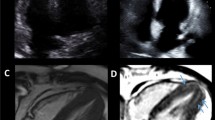Abstract
Background: We investigated whether myocardial thallium-201 defects in patients with apical hypertrophic cardiomyopathy are associated with an unfavorable clinical outcome, and additionally compared the presence of defects to echocardiography and angiography findings. Methods: Dipyridamole thallium-201 single photon emission tomography was performed in 26 apical hypertrophic cardiomyopathy patients, aged 41–78 (22 men, 6 women). Patients with or without perfusion defects were compared for echocardiographic measurements of wall thickness, chamber dimensions, and fractional shortening. Twelve patients underwent coronary angiography. The occurrence of cardiac events was evaluated during clinical follow-up for a mean period of 4.3 ± 1.9 years (range: 1.0–7.0 year). Results: Thirteen patients (50%) showed perfusion defects, which were predominantly reversible (fixed in 1) and mostly apical (9 of 13). Patients with and without defects did not differ in symptoms, EKG findings, echocardiographic morphology or fractional shortening (41 ± 4 vs. 41 ± 7%). Coronary angiography was normal in all patients in whom it was performed (nine with and three without defects). During follow-up, there were no deaths or myocardial infarction. Of the defect positive group, one case developed paroxysmal supraventricular tachycardia, and another had a cerebrovascular accident. Of the defect negative group, one case developed sick sinus syndrome, while another had a hospital admission for anginal pain. Conclusions: While reversible thallium defects in the absence of coronary artery disease occur frequently in patients with apical hypertrophic cardiomyopathy, the prognosis remains benign despite the presence of ischemia and there is no evidence for an association with adverse patient outcome.
Similar content being viewed by others
References
Cero E, Nichols PF, Maron BJ. Heterogeneous morphologic expression of genetically transmitted hypertrophic cardiomyopathy: two-dimensional echocardiographic analysis. Circulation 1983; 67: 1227–1233.
Sakamoto T, Tei C, Murayama M, Ichiyasu H, Hada T. Giant T wave inversion as a manifestation of asymmetrical apical hypertrophy of the left ventricle: echocardiographic and ultrasono-cardiotomographic study. Jpn Heart J 1976; 17(5): 611–629.
Webb JG, Sasson Z, Rakowski H, Liu P, Wigle ED. Apical hypertrophic cardiomyopathy: clinical follow-up and diagnostic correlates. J Am Coll Cardiol 1990; 15(1): 83–90.
Okishige K, Sasano T, Yano K, Azegami K, Suzuki K, Itoh K. Serious arrhythmias in patients with apical hypertrophic cardiomyopathy. Intern Med 2001; 40(5): 396–402.
Kusukawa J, Suwa M, Nakayama Y, et al. Advanced sequelae of apical hypertrophic cardiomyopathy: report of two cases with wall motion abnormalities. J Cardiol 1988; 18(1): 259–269.
Suganuma Y, Shinmura K, Hasegawa H, Tani M, Nakamura Y. Clinical characteristics and cardiac events in elderly patients with apical hypertrophic cardiomyopathy. Nippon Ronen Igakkai Zasshi 1997; 34(6): 474–481.
Spirito P, Bellone P. Natural history of hypertrophic cardiomyopathy. Br Heart J 1994; 72(Suppl 6): S10–S12.
Seneviratne SL, Premawardena AP, Ranasinghe GW, Gunatilake SB, de Silva HJ. Apical cardiomyopathy: an important differential diagnosis in ischemic chest pain. Ceylon Med J 1996; 41(3): 109–110.
Sugihara H, Taniguchi Y, Ohtsuki K, et al. Assessment of myocardial perfusion abnormalities in patients with apical hypertrophic cardiomyopathy using exercise 201Tl scintigraphy. Kokyu To Junkan 1993; 41(11): 1089–1093.
Dilsizian V, Bonow RO, Epstein SE, Fananapazir L. Myocardial ischemia detected by thallium scintigraphy is frequently related to cardiac arrest and syncope in young patients with hypertrophic cardiomyopathy. J Am Coll Cardiol 1993; 22: 796–804.
Yamada M, Elliott PM, Kaski JC, et al. Dipyridamole stress thallium-201 perfusion abnormalities in patients with hypertrophic cardiomyopathy. Eur Heart J 1998; 19: 500–507.
Amanullah AM, Kiat H, Friedman JD, Berman DS. Adenosine technetium-99m sestamibi myocardial perfusion SPECT in women: diagnostic efficacy in detection of coronary artery disease. J Am Coll Cardiol 1996; 27(4): 803–809.
Sakamoto T, Suzuki J. Apical hypertrophic cardiomyopathy. Nippon Rinsho 2000; 58(1): 93–101.
Doi YL, Hamashige N, Yonezawa Y, Ozawa T. Apical hypertrophic cardiomyopathy and ventricular tachycardia. Eur Heart J 1984; 5(10): 824–828.
Eriksson MJ, Sonnenberg B, Woo A, et al. Long-term outcome in patients with apical hypertrophic cardiomyopathy. J Am Coll Cardiol 2002; 39(4): 638–645.
Lorenzoni R, Gistri R, Cecchi F, et al. Coronary vasodilator reserve is impaired in patients with hypertrophic cardiomyopathy and left ventricular dysfunction. Am Heart J 1998; 136(6): 972–981.
Fujimoto S, Komoto Y, Sakaguchi Y, Mizuno R, Dohi K, Nakano H. Apical hypertrophy with massive myocardial fibrosis: comparison with electrocardiographic changes. Intern Med 1998; 37(5): 457–462.
Rivera-Diaz J, Moosvi AR. Apical hypertrophic cardiomyopathy. South Med J 1996; 89(7): 711–713.
Sumino S, Sugimoto T, Koide T, Murao S. Necropsy finding in a patient with apical hypertrophic cardiomyopathy. Jpn Heart J 1985; 26(2): 297–303.
Takata J, Counihan PJ, Gane JN, et al. Regional thallium-201 washout and myocardial hypertrophy in hypertrophic cardiomyopathy and its relation to exertional chest pain. Am J Cardiol 1993; 72(2): 211–217.
Cannon RO III, Dilsizian V, O'Gara PT, et al. Myocardial metabolic, hemodynamic, and electrocardiographic significance of reversible thallium-201 abnormalities in hypertrophic cardiomyopathy. Circulation 1991; 83(5): 1660–1667.
Maron BJ, Bonow RO, Cannon RO, Leon MB, Epstein SE. Hypertrophic cardiomyopathy: interrelation of clinical manifestations, pathophysiology, and therapy. N Engl J Med 1987; 316: 780–789.
Suzuki J, Shimamoto R, Nishikawa J, et al. Morphological onset and early diagnosis in apical hypertrophic cardiomyopathy: a long term analysis with nuclear magnetic resonance imaging. J Am Coll Cardiol 1999; 33(1): 146–151.
Rubin KA, Morrison J, Padnick MB, et al. Idiopathic hypertrophic subaortic stenosis: evaluation of anginal symptoms with thallium-201 myocardial imaging. Am J Cardiol 1979; 44(6): 1040–1045.
Author information
Authors and Affiliations
Rights and permissions
About this article
Cite this article
Lee, KH., Jang, HJ., Lee, S.C. et al. Myocardial thallium defects in apical hypertrophic cardiomyopathy are associated with a benign prognosis. Int J Cardiovasc Imaging 19, 381–388 (2003). https://doi.org/10.1023/A:1025807125699
Issue Date:
DOI: https://doi.org/10.1023/A:1025807125699




